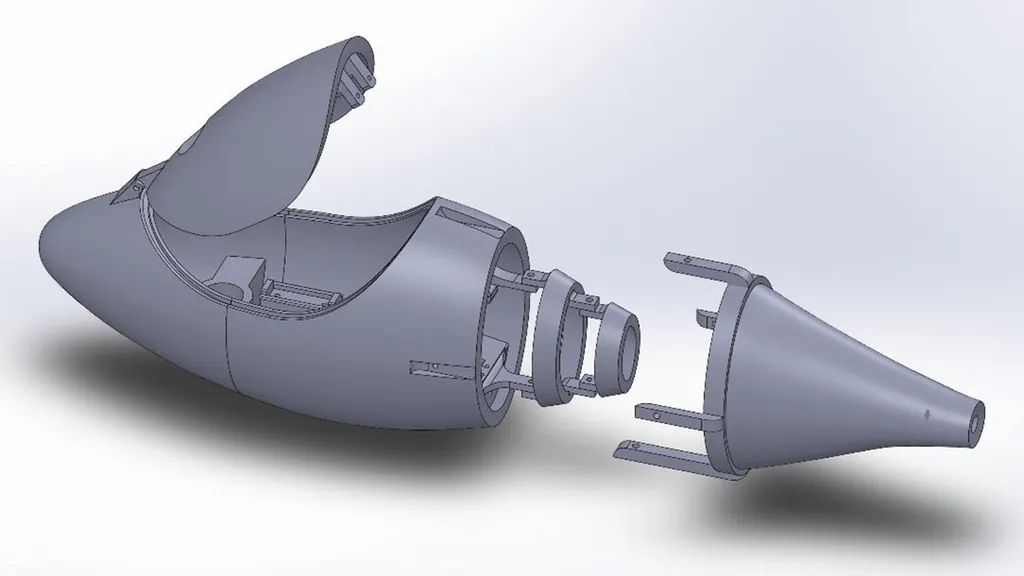- April 01, 2025
- By John Tucker
Growing up in Spain, Cecilia Huertas Cerdeira was captivated by the elegant movements of aquatic life during frequent vacations to the Atlantic coast. Later, as a doctoral student at the California Institute of Technology, she steered her surfboard into Pacific waves.
Now a University of Maryland assistant professor of mechanical engineering, she retains this oceanic focus as she works to improve underwater drones, which have progressed in recent years but lack the speed and agility of their airborne cousins. Huertas Cerdeira plans to help them catch up.
She has launched a project to build an unmanned underwater vehicle (UUV) powered by a robotic fin. Modeled after the rear fin of a tuna fish, the replica will propel the drone into deep waters with more quickness and maneuverability than present-day versions.
“I’m taking inspiration from biological swimmers that have evolved over millions of years and can move more efficiently than anything with a rotating propeller,” Huertas Cerdeira said. “We can’t build a fish. But we can build a robot that moves like a fish and optimize it.”
Funded by a National Science Foundation grant awarded in December, the project is based on a research paper cowritten by Huertas Cerdeira and recently published in Scientific Reports. (Another of her drone projects—one aimed at developing an on-board energy harvesting system for long endurance earth observation unmanned aircraft—received a UMD Grand Challenges individual project grant.)
Her research team aims to build the fin and test it in a water tunnel at UMD’s Hydrodynamics Lab by the end of the year. Once the drone is complete, hopefully in two or three years, they will perform tests at the Maryland Autonomous Technologies Research Innovation and eXploration lab in Southern Maryland.
[UMD to Develop Drone-Delivery Program for Patients on Rural Island]
Huertas Cerdeira’s research dovetails with increasing global reliance on UUVs for tasks that would be too expensive or dangerous for submarine crews. Underwater drones are cheaper to build and operate, and they poke around aquatic crannies in unique ways, photographing leaky oil pipes, measuring polar ice shelf temperatures, cleaning up waste, studying marine life and conducting military tasks like blowing up mines.
But often, their voyages are neither smooth nor speedy. Conventional UUV thrusters jut out sideways, reducing clearance and increasing drag, while whirring motors can spook fish or blow the cover of stealthy military.

“Aerial drones are about a decade ahead of their maritime counterparts,” said Rob Nicholson, a Navy Reserve oceanography officer and affiliated scientist for the University of Delaware who specializes in what's commonly called "blue tech." The Department of Defense and oil and gas industry have been early investors in UUVs, he said, but "as commercial developers continue to innovate, they will increasingly turn to academia, where many new breakthroughs can occur."
Fish tailfins are quiet and streamlined, and Huertas Cerdeira is confident a mechanical version will maintain their same performance. An expert in fluid mechanics, she studies how objects bend and move as they travel through air or water. Early in her career she focused on wind turbines before shifting her attention to traditional drones and, more recently, UUVs.
Through her work, she learned that fish evolved into master swimmers by redistributing the stiffness of their fins while fighting through the forces of water. As they flap, their fins continuously change shape, going flexible on one area while stiffening up elsewhere—demonstrating a fluidity that bears little resemblance to passive, two-dimensional propellers.
Considering the constraints of modern-day underwater drones, Huertas Cerdeira wondered if she could power one with a robotic fin that mimics the stiffness distribution tuna use when swimming. The team would accomplish this by equipping the fin with several cavities they can fill with pressurized air and then deplete it, imitating a fish’s dynamics.
“There are a lot of very cool solutions that nature has come up with that we don’t always think about as engineers,” she said.
Overall, she hopes the work will inform future bio-inspired UUVs and encourage aquatic explorations worldwide. “Improved propulsion systems can help push our underwater activities to the next level,” she said.
Topics
Research